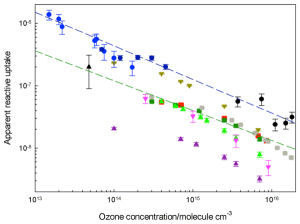Reactive uptake on aerosol

It is now known that organic components may constitute 20-60% of particles depending on the location. In collaboration with the Chemistry, spectroscopic studies of organic and mixed organic/inorganic aerosols are performed in a custom-built aerosol flow tube (AFT) reactor fitted with an IR probe supported by on- and off-line analysis using mass spectrometry (ESI and CIMS) and chromatography (GC/MS and LC/MS). For climate models to capture aerosol behaviour in an evolving atmosphere, it is necessary for them to include not only detailed chemical and physical information about composition, reaction mechanisms, kinetics, component vapour pressures, refractive indices and sizes but also how these parameters and properties change over time, which occurs via reaction (mainly oxidation by O3 and OH) and equilibrium partitioning (evaporation of more volatile species from and condensation of less volatile species). Our studies are therefore aimed at the development of new experiments to follow the kinetics and mechanisms of aerosol chemistry alongside measurements of their transformations. Current studies are concentrating on the oxidation of mixed organic/inorganic aerosols over a range of relative humidity to establish its effect on reactivity and partitioning of products.